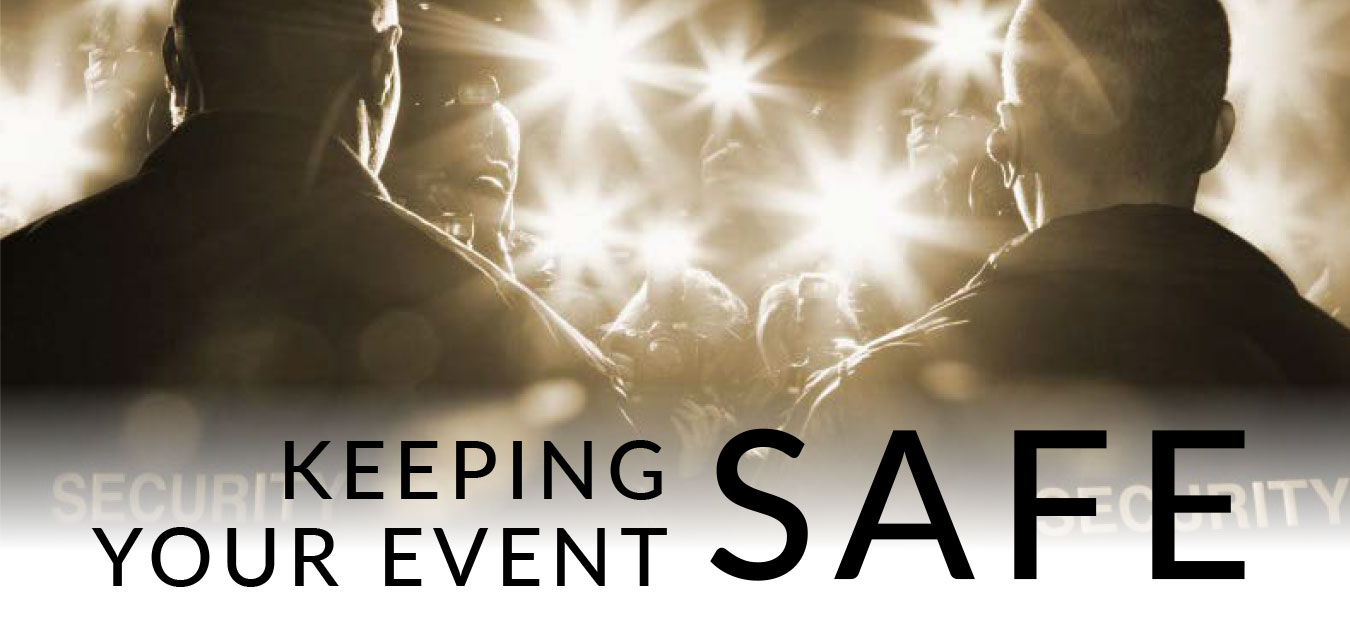KEEPING YOUR EVENT SAFE
January 2018 | By Hala Bissada, CFRE

In light of recent events, including the deadly blast at the Ariana Grande Concert and the terrorist attack with a borne vehicle in New York, I thought it timely to remind event organizers how to keep your event safe.
In the world we live in, event planners need to think about the unimaginable and to do everything reasonable to ensure our attendees, staff, vendors remain safe. Effective planning is the first line of defense. Below are some specific measures you can take.
STAFF TRAINING
Train your key staff on what to do during an emergency situation. Ensure they understand the appropriate terminology, to help them articulate what is happening. This may save valuable minutes in an emergency situation. Make sure your team knows how to identify suspicious activity and where to report it. Train them on things like the HOT protocol in terms of suspicious packages.
- Hidden — Does it look like it has been deliberately hidden
- Obviously Suspicious — Does it have wires, circuit boards etc. do you think it poses an immediate threat?
- Typical — Is the item typical of what you would expect to find in this location?
Rehearse various scenarios with your team.
EMERGENCY PLAN & PROCEDURES MANUAL
Ensuring you have a comprehensive emergency plan and procedures manual is imperative. Preparing this document will allow you to think of the possible threats, challenges, vulnerabilities that you may face and how to address them.
Key components of the manual should include the following:
- Outline of the Event Team and assignments including who is overall responsible for the event, but who in particular is responsible for safety and security, fire, first-aid and medical response, and other key responsibilities depending on your event & venue
- Risk Assessment, Mitigation and response measures for things like Terrorist threats & attacks, Inclement Weather, Act of Violence or Criminal Acts, Injuries requiring medical attention, Public Order Incidents, Lost and Stolen Property
- Procedures section outlining what you will have in place for First Aid, Security etc. and how to respond to certain situations like the discovery of contraband such as alcohol, narcotics or weapons or to criminal acts. In addition, documenting log keeping procedures are important
- Emergency Plan—in this section you should outline how to address extreme heat, cold weather or stormy weather, how to deal with bomb threats, bomb explosion, intoxicated or non-intoxicated individuals causing disturbances, fire, stampede, extended power outage etc.
- Site Plan
- Evacuation Plan
SITE VISITS
Part of the initial planning should include in-depth site visits to determine evacuation routes (exterior perimeters, ingress/egress points i.e. chokepoints, bottlenecks etc.). Determine possible “lock-down” areas to restrict access to victims if applicable. In addition, doing a walkthrough with law enforcement is always valuable.
MULTI-AGENCY APPROACH
Multi-Agency cooperation in the planning for events is vital to assist in developing mitigation strategies. Make sure the local authorities have as much information as possible.
COMMUNICATION
If applicable coordinate a communication team which is fully responsible for disseminating information in the event of an emergency. Determine recommended methods of staff communication (i.e. mass email, call trees, etc.) and establish relevant communication procedures. Create an on-site communication control centre.
SOCIAL MEDIA MONITORING
Check what is being posted on social media platforms. Monitoring these platforms could provide you with insight into potential threats.
ACCESS ACCREDITATION
Establish an accreditation system and ensure all those involved in the event are wearing the appropriate accreditation and there is a protocol for checking accreditation.
SPECIALISTS
If needed bring in specialists. For example bring in Crowd and Safety specialists, if your event could benefit from that kind of support.
SCREENING MEASURES
Implement effective screening measures i.e. metal detectors, bag searches, pat downs etc. Interestingly on a side note, the need to safeguard today’s venues (arenas, hotels, concert halls etc.) has spawned new software development that aims to instantly identify concealed weapons for civilian protection for example. Companies like Patriot One Technologies in partnership with researchers from Canada’s McMaster University have developed a
current solution.
SPECIAL MEASURES
An example of a special measure would be to mitigate the threat of an attacker using a vehicle to cause your attendees harm. This threat can be mitigated by landscaping or using physical measures such as the following:
- Use large vehicles to create soft road closures into an event footprint. This is a flexible solution to deploy, and can be redeployed and moved in short notice
- Use of pedestrian barriers or fencing to act as a slowing mechanism
- Using event equipment such as large generators, forklifts etc. to slow vehicles down
It is not possible to plan a response to every conceivable type of attack, but by continuing to do our due diligence with respect to emergency planning, we can be better prepared to keep our events safe.
This article was originally published in the January 2018 issue of Canadian Special Events Magazine.
Share
